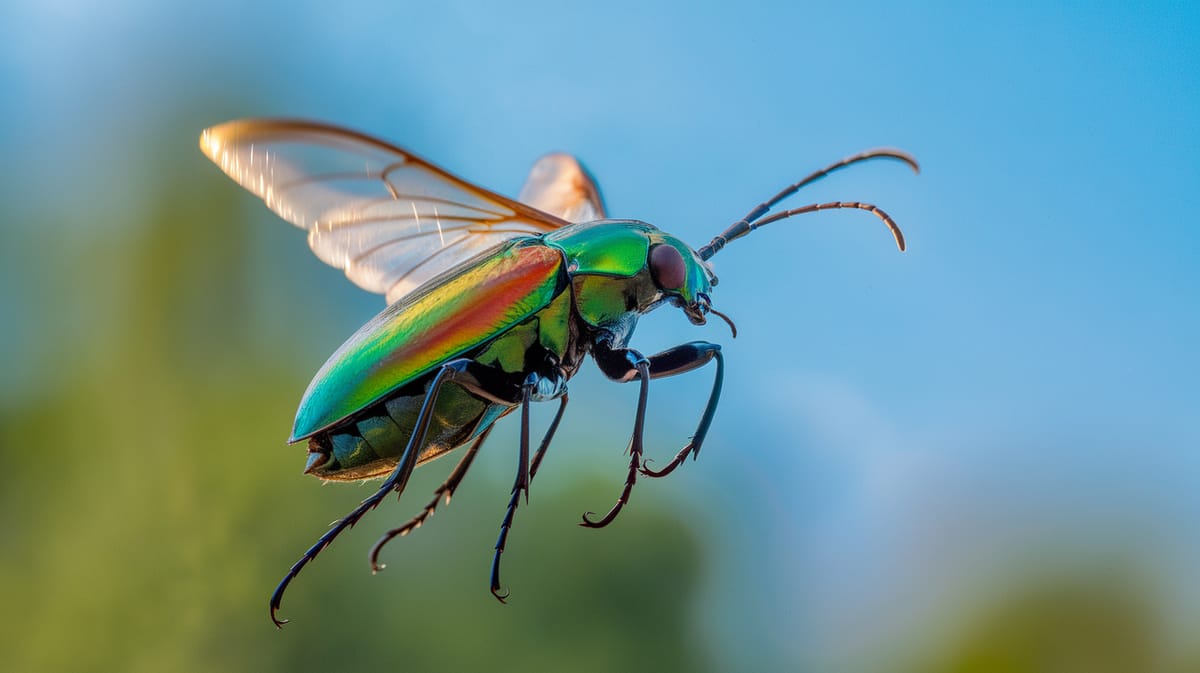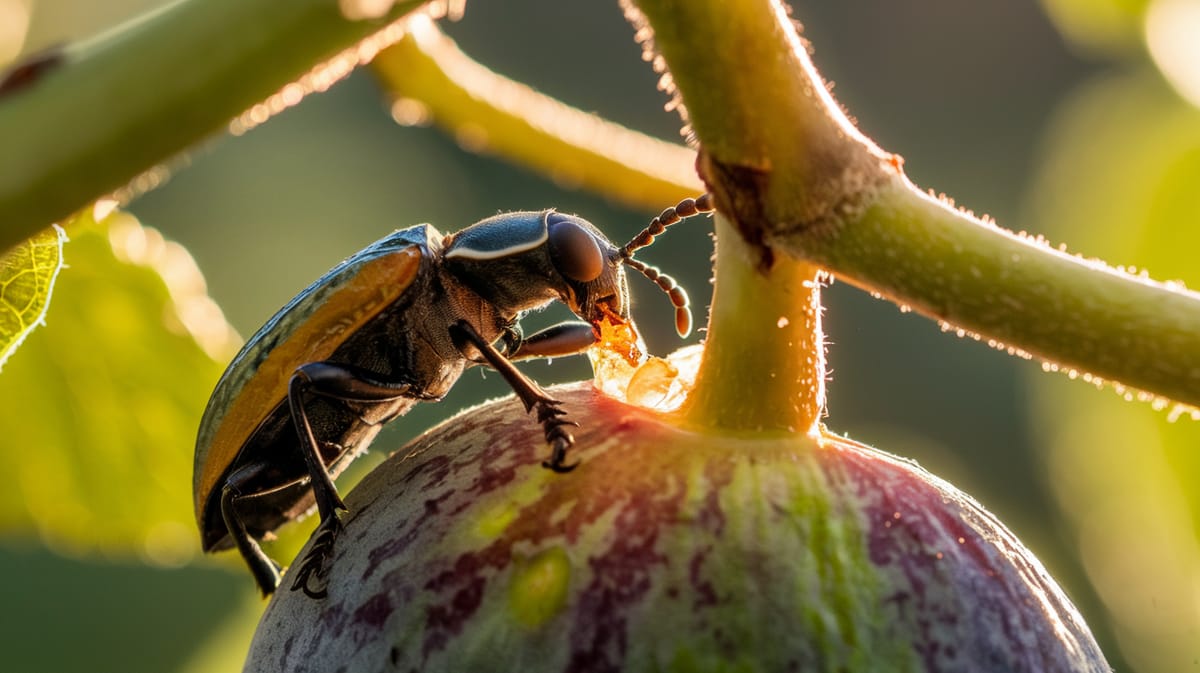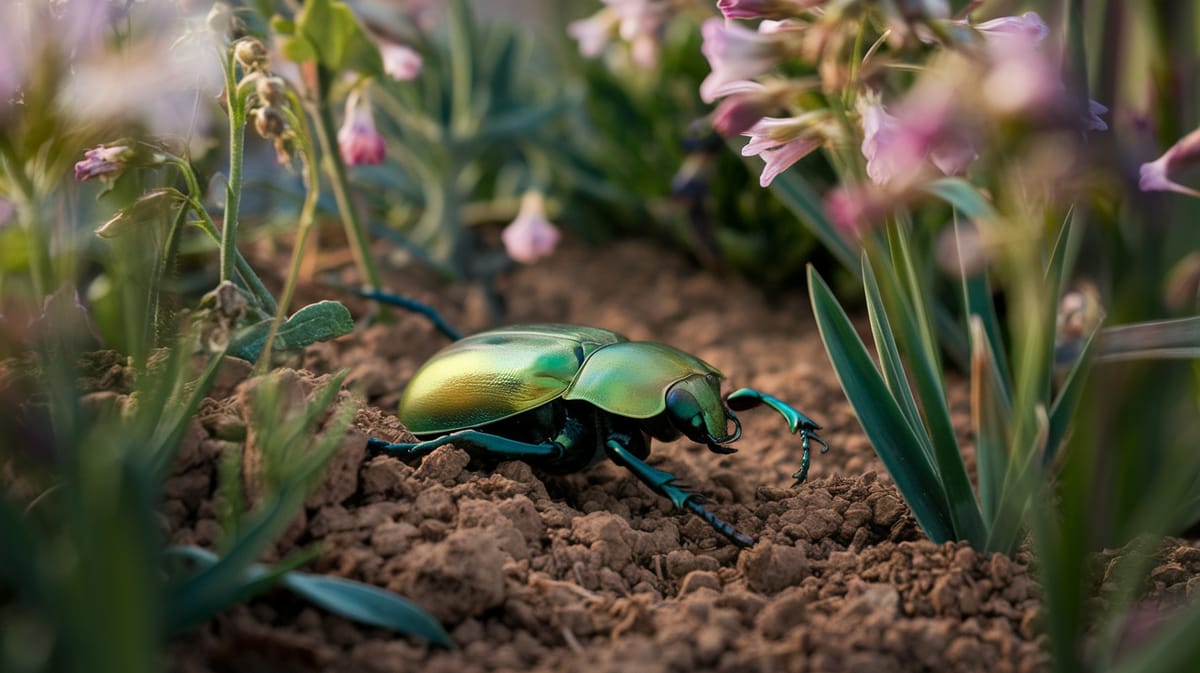Figeater Beetle
Emerald-colored and buzzing with energy, the Figeater Beetle brings vibrancy to gardens while playing a crucial role in decomposing overripe fruit. These beetles are known for their powerful, yet clumsy flight.

Key Insights at a Glance
Did You Know?
Taxonomy & Classification
Figeater beetles are vibrant, metallic green insects known for their role in breaking down decaying organic matter, contributing to nutrient cycling. Let's understand the evolutionary journey and classification of these remarkable decomposers.
Species Diversity
Figeater beetles belong to the genus Cotinis, comprising approximately five species, prominently found in the Americas.
Evolutionary Success
These beetles have thrived since the Cenozoic era, adapting to various environments and contributing to the ecological balance.
Lifecycle and Growth
A remarkable journey of transformation from Egg to Adult.
Egg
Eggs are laid in soil, where they remain protected, developing into larvae ready to begin their next life stage.
Larva
Larvae, known as grubs, feed on decaying organic matter in the soil, growing rapidly and storing energy for pupation.
Pupa
In a pupal chamber underground, the larvae undergo metamorphosis, transforming into adults with wings and distinct coloration.
Adult
Adults emerge with iridescent green bodies and engage in mating and feeding on ripe fruits, contributing to seed dispersal.
Dietary Habits
A skilled feeder with a taste for fruit, this beetle thrives in orchards, exploiting its ability to locate ripe produce.
| DIET TYPE | DESCRIPTION |
|---|---|
| Primary Diet | Primarily consumes soft, ripe fruits such as figs and peaches, using its strong mandibles to break the skin. |
| Secondary Diet | Occasionally feeds on nectar and pollen from flowers, playing a role in pollination while seeking additional nutrients. |
| Occasional | Rarely consumes sap from tree wounds or other beetles' larvae, depending on resource availability and environmental conditions. |

Behaviour and Adaptations
Discover the fascinating traits and adaptations that make the Figeater Beetle a standout in the insect world.
Flight Agility
Expert fliers capable of rapid maneuvers to avoid predators.
Vibrant Display
Shiny green exoskeleton deters predators by reflecting sunlight.
Efficient Foraging
Skillfully locates and consumes ripe fruits with ease.
Ecosystem Impact
Figeater Beetles play a crucial role in sustaining ecological balance through their unique contributions.
Pollination Assistants
Figeater Beetles aid in pollination by transferring pollen as they feed on flowers.
Nutrient Recyclers
They help decompose organic matter, enriching the soil with nutrients.
Prey for Wildlife
Serve as an essential food source for birds and small mammals.
Conservation Challenges
Addressing the major threats faced by Figeater Beetle populations.
Habitat Loss
Urban development and agriculture reduce natural habitats for Figeater Beetles.
Pesticide Use
Chemical pesticides harm beetle populations and disrupt ecosystems.
Climate Change
Altered weather patterns affect the lifecycle and distribution of Figeater Beetles.
Frequently Asked Questions
How long do Figeater Beetle live?
Figeater beetles typically live for about one to two months as adults. Their entire life cycle, from egg to adult, can last around one year, with much of that time spent in the larval stage beneath the soil.
What do Figeater Beetle eat?
Figeater beetles primarily feed on ripe fruits such as figs, peaches, plums, and berries. They are also known to eat nectar and flower petals. As larvae, they consume decomposing organic matter and soil.
Are Figeater Beetle poisonous?
Figeater beetles are not poisonous. They are harmless to humans and pets. Their primary defense mechanism is their hard exoskeleton, which protects them from predators.
Are Figeater Beetle endangered?
Figeater beetles are not considered endangered. They are common in their native habitats across the southwestern United States and Mexico, thriving in areas with abundant fruit and flowers.
What do Figeater Beetle symbolize?
In various cultures, beetles, including the Figeater, symbolize transformation, renewal, and change due to their metamorphic life cycle. They are often seen as symbols of persistence and adaptability.
Do Figeater Beetle bite?
Figeater beetles do not bite humans. They have mandibles used primarily for feeding on fruits and flowers, not for defense or aggression. They are generally docile and pose no threat to people.
What color are Figeater Beetle?
Figeater beetles are metallic green with a shiny appearance. Their bodies often have a bronze or yellowish hue, especially on the underside, making them quite striking and noticeable in their natural environment.
Does a Figeater Beetle have wings?
Yes, Figeater beetles have wings. They possess two pairs of wings: the outer pair is hard and protective (elytra), while the inner pair is membranous and used for flying. They are strong fliers despite their clumsy movements.
What does a Figeater Beetle look like?
Figeater beetles are large, metallic green insects with a robust body, measuring about 1.25 inches long. They have a distinctive sheen and sometimes display a bronze or yellowish underside. Their legs and antennae are also notable features.
Is a Figeater Beetle an insect?
Yes, a Figeater beetle is an insect. It belongs to the Scarabaeidae family, which includes scarab beetles. Like all insects, they have a three-part body structure: head, thorax, and abdomen, along with six legs and two antennae.
Related Insects
Discover insects with similar characteristics to Figeater Beetle - including shared habitats, diets, and taxonomic classifications
Share this profile
Help others discover Figeater Beetle
